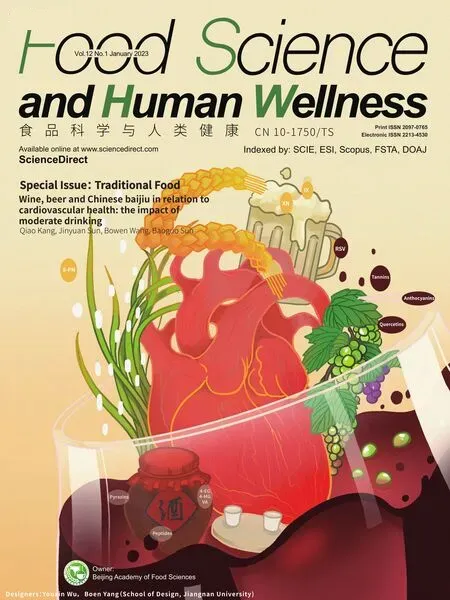Physicochemical, rheological and antioxidant prof iling of yogurt prepared from non-enzymatically and enzymatically hydrolyzed potato powder under refrigeration
2023-01-22IshtiqAhmZhouyiXiongHnguoXiongRnMuhmmAilNumnKhliAllhBkshJviLkhooZiinAsNwzNomnWlytRoSnullhKhn
Ishtiq Ahm, Zhouyi Xiong*, Hnguo Xiong,*, Rn Muhmm Ail, Numn Khli,Allh Bksh Jvi Lkhoo, Zi-u-in, As Nwz, Nomn Wlyt, Ro Snullh Khn
a College of Food Science and Technology, Huazhong Agricultural University, Wuhan 430070, China
b Fisheries Research Institute, Wuhan Academy of Agricultural Sciences, Wuhan 430207, China
c National Institute of Food Science and Technology, University of Agriculture, Faisalabad 38000, Pakistan
d Schools of Food and Agricultural Sciences, University of Management and Technology, Lahore 54000, Pakistan
e College of Food Science and Technology, Zhejiang University of Technology, Hangzhou 310014, China
Keywords:Storage stability Potato powder Yogurt Rheology Microbiology Antioxidant activity
A B S T R A C T Evidences show that the storage period greatly affects the quality of yogurt. In this study, three types of yogurt:control yogurt (CY), non-hydrolyzed potato powder yogurt (PPY) and enzymatically hydrolyzed potato powder yogurt (EHPPY) were prepared at 42 °C for 5 h and stored for 28 days at 4 °C. The yogurts were evaluated for quality characteristics at different storage periods. Negligible differences in pH values, titratable acidities and viable counts were detected in all three types of yogurt during storage. However, compared to other yogurts, EHPPY exhibited desirable water holding capacity, throughout the storage period. Apart from this, sensory properties and antioxidant activities (2-diphenyl-1-picryl-hydrazyl (DPPH) free radical scavenging activity and ferric reducing antioxidant power (FRAP)) of EHPPY were also significantly improved during the storage period. Furthermore, the storage (G′) and loss (G″) modulus of PPY, EHPPY were lower than CY at 4 °C while a hysteresis loop was shown by all yogurts at the temperature range of 4-50 °C indicating higher G′ (elasticity) than G″ (viscosity). Based on our findings, EHPP could be an important functional ingredient in improving the quality and storage stability of yogurt for its production at an industrial level.
1. Introduction
Yogurt is an important diary foodstuff containing all essential nutrients required for health and it is usually prepared by addingLactobacillus acidophilus,Lactobacillus delbrueckiisp.BulgaricusandStreptococcus thermopilesbacteria as a starter culture in heated milk [1,2]. The quality characteristics of yogurt depend on gel formation, texture and internal microstructure that developed due to the clotting features of milk protein called casein [3]. During this process, the pH of milk becomes acidic and a three-dimensional network of milk proteins facilitates the firmness of yogurt gel, mainly caused by proteolytic activity of the employed culture, acidification rate and total solids [4]. Since the shelf life of yogurt is low, thus,studying the shelf life of yogurt is an important concern especially prepared with heterogeneous ingredients [5]. During cold storage, the addition of probiotic strain and different fortified substances are the key determinants of yogurt acidification [6]. Increase in the amount of unassociated organic acids in the fermented products due to low pH imparts bactericidal potential to these products [7].
The understanding of the physical properties of a product like yogurt is very important before formulated for sensory evaluation [8].The sensory analysis and color are positively correlated with food preferences [3,9]. Water holding capacity (WHC) is also very important parameter for yogurt quality and affected by the addition of fruit and other plant-based material [10,11]. It was suggested that the yogurt prepared with fruits could make a substantial position from the nutritional viewpoint and as a potential natural stabilizer [12,13].To increase the health benefits and enhancement of antioxidant properties of yogurt, it has previously been fortified with the addition of calcium, vitamins, fibers, natural extracts nutrients of animals and plants [14]. The antioxidant activity of yogurt is effectively improved by the addition of plant polyphenols [15]. Recently, lyophilized marigold extract has been used as ingredients to improve the sensory properties and antioxidant activity of organic yogurt [16]. To improve the industrial value of yogurt in terms of viscosity, several innovative formulations ingredients and gums have been implemented [17,18].
Potato is a source of several vitamins, proteins, minerals,flavonoid, phenolic compounds, which are also well known due to its antioxidative activities and health-related benefits [19-21]. Phenolic compounds present in foods have lower the risk of health disorders because of their antioxidant activity [22,23]. Potato powder (a processed product of potato obtained after boiling, mincing, baking and grinding) despite being highly stable during cooling and heating,it is seldom used in industry for different food formulations [24].Potato powder has been used as color, thickening and gel-forming agent, while it improves the dough rheology and swelling ability which makes it a potential candidate in different functional food formulations especially for thermal processing [25].
The dairy products are become the fastest-growing sector in the functional foods market and increased the number of consumers that are interested to improve their health quality [26]. There are numerous reports available on the preparation of yogurt, however, a few reports narrate its storage stability, as it is an important concern while developing a new product. Up to the best of our knowledge, there is no such study available that highlights the use of non-enzymatically hydrolyzed and enzymatically hydrolyzed potato powder as a component in the formulation of fermented dairy products having different storage time. Therefore, we aimed to investigate the effect of non-enzymatically hydrolyzed and enzymatically hydrolyzed potato powder on acidification, microbiological, water, holding capacity, antioxidant, rheological, microstructural, color, and sensory properties of yogurt at different storage periods. Our study indicated that enzymatically hydrolyzed potato powder (EHPP) improved the aforementioned properties of yogurt more than non-EHPP during the storage period for 4 weeks at refrigerator temperature.
The novel EHPP not only improves the quality but also has numerous health benefits after combining with milk proteins.Moreover, this study also highlights on the increased consumer’s acceptability and prolonged commercialization of dairy products. In the meantime, it also signifies the importance to utilize the EHPP in dairy fermented products, which would be helpful to promote the development of EHPP and fermented dairy industry.
2. Materials and methods
Potato powder containing protein (8.6%), moisture (7%), fat (1%),carbohydrates (81.7%) and sodium (35 mg/100 g) was obtained from Zhangjiakou Yunbie Potato Development Company Hubei, China.Skimmed milk powder having the desired composition of protein(33.4%), fat (0.8%), carbohydrates (54%) and sodium (390 mg/100 g),purchased from Mother and Infant Products Co., Ltd. Dongcheng District, Beijing, China. Whole milk powder (protein 23.5%), fat (26%),carbohydrates (41.5%) and sodium (320 mg/100 g) was obtained from Qiqiharhe Dairy Co., Ltd., Heilongjiang, China. A mixed starter culture ofL. bulgaricus, andS. thermopilesfrom Beijing Chuanxiu Technology, Co., Ltd., Beijing, China were used andα-amylase(4 000 U/g) was purchased from Beijing double Helix Microbial Culture Media Product Field, Beijing, China. The chemical reagents used in the study have a pure analytical grade.
2.1 Preparation of enzymatically hydrolyzed potato powder (EHPP)
EHPP was prepared by following the method [27] with some modification. Briefly, potato powder was mixed with water (1:8),respectively and addsα-amylase 0.015 g/100 g at 50 °C with a magnetic stirrer (DF-101S type, Wuhan Hengtaida Instrument Equipment Co., Ltd., Wuhan, China) for 30 min and followed by heating for 10 min more on boiling water.
2.2 Preparation of yogurt
Three groups of yogurt samples were prepared using nonenzymatically hydrolyzed potato powder (PP), EHPP with whole milk powder (WMP) according to 1:3 (m/m), respectively by following procedure [28] with some modification. The mixture of EHPP and WMP was added in water according to 1:6 ratios and control yogurt (CY)were prepared with WMP and water according to 1:6 respectively by addition of 3% sugar in each group following the previous study of Chollet et al. [29] with modification. The mixture is then stirred and heated in a water bath (HH-Z type, Changzhou Guohua Electric Co., Ltd., Changzhou, China) at 90 °C for 15 min. The heated mixture after cooling to 42 °C was inoculated with 6% reactivated starter culture ofL. bulgaricus, andS. thermopilesand kept for 5 h at 42 °C in incubator until coagulation. The resultant CY, nonhydrolyzed potato powder yogurt (PPY) and enzymatically hydrolyzed potato powder yogurt (EHPPY) were prepared in triplicate and stored at 4 °C for 1, 7, 14, 21 and 28 days.
2.3 Determination of titratable acidity and pH
The acidity of yogurt samples was measured by the following Association Official Analytical Cchemist [30] (method No.947.05)and was expressed as a percentage. The pH value was determined by inserting 10.0 g of CY, PPY, and EHPPY samples directly using the calibrated digital pH meter (PHS-3 pH Shanghai Electronic Co.,Ltd., Shanghai, China) by following the Association official analytical chemist [30] (method No.981.81).
2.4 Determination of total viable count of lactic acid bacteria (LAB)
Total viable counts of LAB were performed after being stored at 4 °C for the 1, 7, 14 21 and 28 days. Serial dilutions (10-1-10-7) were made for CY, EHPPY and PPY after storage in refrigeration at 4 °C for 1, 7, 14, 21 and 28 using sample and water ratio (1:9) respectively.LAB colonies counts were performed on de Man, Rogosa and Sharpe(MRS) agar following anaerobic for 72 h at 37 °C [31]. The result was interpreted as the logarithms of the number of colony-forming units per mL (lg(CFU/mL)).
2.5 Color analysis
The color parameters of yogurt were measured as lightness (L*),redness/greenness (a*) and yellowness/blueness (b*) of CY, PPY, and EHPPY sample after storage in refrigeration at 4 °C for 1, 7, 14, 21 and 28 days using a CR-300 Minolta colorimeter (Osaka, Japan).
2.6 Determination of WHC
WHC of CY, PPY, and EHPPY was determined by the method previously reported method [32]. Briefly, the supernatant obtained after centrifugation of samples at 4 000 r/min for 10 min was drained off and the pellet at the bottom of the tube was weighed. WHC was calculated using the following Equ. (1).

2.7 Determination of antioxidant activity
Yogurt samples (10 g) were weighted, and then 80% methanol(30 mL) was added and properly mixed. After that, the obtained mixture was sonicated (100 W for 20 min) and centrifuged for 10 min at 4 000 r/min. The centrifuged supernatant was stored at 40 °C for further antioxidative analyses.
2.7.1 Determination DPPH free radical scavenging activity
Antioxidant activity of CY, PPY and EHPPY samples by DPPH inhibition was determined following the modified method [33] using 2,2-diphenyl-1-picryl-hydrazyl Kit of Sigma-Aldrich (Steinheim,Germany). After 1, 7, 14, 21 and 28 days of storage, 30 mL methanol(80%,V/V) was added to 10.0 g of PPY, EHPPY and CY and mix thoroughly. The mixture was then subjected to ultrasound at 100 W for 20 min followed by centrifugation at 4 000 r/min for 10 min.The supernatant obtained was then subjected to antioxidant activity determination. Methanol extracts (0.5 mL) prepared from yogurt samples were thoroughly homogenized with 4.0 mL of ethanolic solution of (50.0 mg of DPPH in 1 L of methanol) having free radical added. Then, distilled H2O was added to adjust the volume to 10.0 mL. This mixture was incubated in dark at room temperature for 30 min. The absorbance was measured at 517 nm through spectrophotometer and sterilized water was used as blank. The DPPH free radical scavenging ability was then determined as the percentage inhibition of DPPH free radical. The following Equ. (2) was used to calculate the percentage inhibition of DPPH free radical by each CY,PPY and EHPPY samples.

WhereA1is absorbance of DPPH, andA2is absorbance test samples.
2.7.2 Ferric reducing antioxidant power
Ferric reducing antioxidant power (FRAP) value of yogurt samples was determined by following the method [34] with slight changes. The FRAP reagent solutions was prepared containing acetate buffer (300 mmol/L), TPTZ reagent (8 mmol/L) and FeCl3(20 mmol/L) at a ratio of 10:1:1 (V/V). The yogurt samples were extracted using methanol and 0.5 mL of the extract was mixed with 3.0 mL of FRAP reagent. The mixture was incubated in a water bath at 37 °C for 10 min. The absorbance was measured at 593 nm using a spectrophotometer and distilled water was used as a blank.A calibration curve of ferrous sulphate solution was prepared with different quantities ranging 200-1 000 μmol/L and results were articulated as mmol FeSO4/g yogurt.
2.8 Determination of rheological study (temperature ramp)
Dynamic oscillation tests of CY, PPY and EHPPY after storage (1,7, 14, 21 and 28 days) were performed to evaluate the flow behavior and viscoelastic properties of yogurt by the following method [35],with the procedure, using an A DHR 2 rotational remoter (TA instruments Crawley, UK) fitted with a 40 mm diameter stainless steel plate probe with 1 mm gape. To determine the applicable stress and frequency in which storage modulus (G′) and loss modulus (G″)parameters of yogurt samples would exhibit a linear constant rate,dynamic frequency ramp tests and dynamic stress ramp tests were performed at 25 °C (range of frequency from 1 to 10 Hz and stress set as 3 Pa and range of stress from 1 to 10 Pa and frequency set as 2.5 Hz, respectively). Dynamic temperature ramp tests were carried out at 1.0 Pa and 2.0 Hz stress and frequency respectively in the temperature range of 450 °C (heating) and 504 °C (cooling), at a rate of 5 °C/min.Then samples were taken in aliquots from the undisturbed yogurt cup and placed in the center of the rheometer plate; before analysis, the top plate slowly drops at the top of the sample.
2.9 Determination of microstructure
The morphological study of CY, PPY and EHPPY yogurt samples was determined by following the previous study procedure [36]. All yogurt samples were freeze-dried for 32 h under pressure 0.2 millibar fixed in liquid nitrogen using a freeze-dryer (Beta 2-8 LD Freeze Dryer, CHRIST Co., Ltd., Germany). These freeze-dried yogurt samples were mounted on aluminum stubs and coated by gold layer,observations were carried out through scanning electron microscope(SEM) with (× 3 000, 5 μm) magnification (JSM-6390LV; NTC,Tokyo, Japan) and accelerated voltage of 15 kV.
2.10 Sensory evaluation
Sensory evaluation of CY, PPY and EHPPY during storage was carried out and the prepared yogurt was subjected to sensory analysis in order to get consumer’s response. Thirty panelists (20 male and 10 female) having enough knowledge about the quality of the yogurt and food science, belong to the College of Food Science and Technology,Huazhong Agricultural University, Wuhan, Hubei, China was selected to rate the samples based on the 5 points hedonic scale (Excellent = 5,Very good = 4, Good = 3, Average = 2 and Poor = 1). Yogurt samples CY, PPY and EHPPY were analyzed for appearance, texture,taste, aroma, flavor and overall acceptability at 1, 7, 14, 21 and 28 days storage.
2.11 Statistical analysis
One-way analysis of variances (ANOVA) was performed using software Statistics 8.1 (USA). The difference between three times repeated data (storage at 4 °C for 1, 7, 14, 21 and 28 days) was measured at a significance level of 5% (P< 0.05).
3. Results and discussion
3.1 Titratable acidities and pH of yogurt samples during storage

Fig. 1 Effect of added potato powder and EHPP on acidities (a) and pH (b) of EHPPY, PPY and CY during 1, 7, 14, 21, 28 days. Capital letters represent significant difference between different group at the same time, small letters represent significant difference between the same group in different time by one-way ANOVA and Fisher LSD’s test (P < 0.05). Each point corresponds to the average value ± standard deviation. The same below.
Acidity and pH are very important physicochemical parameters for the shelf life of fermented dairy products. Throughout the storage period LAB mediated decomposition of lactose into lactic acid in milk and it is the main cause of acidity in CY, PPY and EHPPY.The coagulation of milk is probably linked to the decrease in pH to a certain extend. When acidity rises to influence level milk might be coagulated. Apart from this, acidity also affects the shelf life of yogurt; therefore, strict monitoring of the acidity of CY, PPY and EHPPY was taken at 1, 7, 14, 21 and 28 days. Fig. 1 showed that added PP and EHPP greatly affected the titratable acidity and pH values of PPY and EHPPY during storage time. Generally,the pH and acidity of PPY and EHPPY showed contrasting trends(decreased pH and increased acidity) with the extended duration of the storage (Fig. 1). However, an increase in acidity and a decrease in pH of CY, PPY and EHPPY were statistically non-significant(P< 0.05). These findings suggest that the acid production rate of LAB fermentation was not significantly affected by adding PP and EHPP. Many other factors, such as different storage conditions,probiotic strains used in yogurt development and different fortified substances also play an important role in the acidification of yogurt [1].A positive effect of acidification rates in the honey fortified yogurt was observed [6], whereas pH values of the PPY and EHPPY sample formulations constantly decreased during storage. Non-significant differences in pH (Fig. 1b) and acidity (Fig. 1a) values of CY, PPY and EHPPY obtained in this work might be connected with the lower production of lactic acid from the expansion of LAB. Similar changes were observed in pH and acidity values of probiotic yogurt upon the addition of Isabel grape [37]. They further revealed that the pH of samples was decreased while acidity was increased during the storage period (1, 7, 14, 21, and 28 days). Similar trend was also observed during storage in previous studies in which the addition of tomato powder has significantly increased the titratable acidity of yogurt whereas a significant decrease was observed in pH after 21 days of storage [38]. So, exact reason for the increase in acidity and a decline in pH counts in PPY, and EHPPY need to be investigated further.
3.2 Color parameter a*, b* and L* of yogurt samples during storage

Fig. 2 Effect of added potato powder and EHPP on color parameters L* (a), a* (b) and b* (c) of EHPPY, PPY and CY during 1, 7, 14, 21, 28 days storage.
Color is a very important parameter for food products. The color shows different behavior during storage time in consumer acceptance and satisfaction [39]. Fig. 2 showed the difference in color (L* anda*,b* values) of supplemented PP, EHPP and CY on the 1stand 28thdays after production. Compared with the sample supplemented with EHPP, theL*value (Fig. 2a) of the sample supplemented with PP was significantly lower (P< 0.05). After 28 days, theL* value in the CY sample was the highest (P< 0.05) compared to all other samples.On the first day, the lowesta* value was observed (Fig. 2c) in the samples PPY and EHPPY, while the highestb* value was observed(Fig. 2b) in the samples with EHPP (P< 0.05). In the PP-added sample, thea* value was the lowest, while theb* value was the highest that is significantly different (P< 0.05) from the EHPPsupplemented sample. Therefore, the results indicate that the PP supplemented sample is darker than the EHPP supplemented and CY sample after 28 days of storage. In addition, compared with other samples, the sample supplemented with PP was more yellow and greener, which is expected due to the yellow color of potato powder. The results of our study consistent with the previous study of prepared yogurt with lentil flour [40]. Wang et al. [24] reported that presence of anthocyanins and carotene in potato and sweet potato flour are responsible for the increaseda* andb* values in value-added products. Since the color difference between PP and EHPP samples is visually perceptible; it is useful to conduct further research on color optimization before any product development for commercialization.
3.3 Total viable counts of LAB in yogurt samples during storage
The viable count of LAB in yogurt is a key determinant of yogurt capability for consumer use. Fig. 3 represents the influence of EHPP and PP on the propagation of viable count of LAB in PPY,and EHPPY during storage. As evident from Fig. 3, the viable count of LAB colonies growth was increased gradually with the assessed storage period and CY exhibited less viable counts of LAB to those in EHPPY and PPY during storage. One of the possible reasons might be the presence of higher fat content in CY which might have induced the growth of LAB [42]. Furthermore, bacterial colonies of LAB increased throughout 21 days of storage and then decreased steadily in CY, PPY and EHPPY, probably due to the natural acidity and a lot of polyphones in PPY and EHPPY restricting the LAB growth during 28 days storage period. A study documented [40] that high concentrations of lintel flour(1%-3%) decreased the bacterial growth exponentially during 28 days storage. However; this growth caused a reduction in pH,which resulted in an increased quantity of dissociated organic acids in PPY and EHPPY. The reduction of pH resulted in the bactericidal ability of these acids and hence the growth of these bacteria was inhibited with the extended storage period.Interestingly, LAB viable counts in EHPPY was still higher than 6.0 lg(CFU/mL) during 28 day of storage, which further authenticated the recommended minimum counts of 6.0 lg(CFU/mL) in yogurt products. Tripathi and Giri [7] stated that pH (below a certain level) could also be responsible for the production of organic acid,thereby improving the bacterial ability of these acids in yogurt as shown in Fig. 3. The decrease in the total viable count of LAB in EHPPY could be due to low pH and polyphenols restricting the growth of LAB in yogurt. Hence, our study suggests that EHPPY can provide a suitable environment for LAB during the storage period.
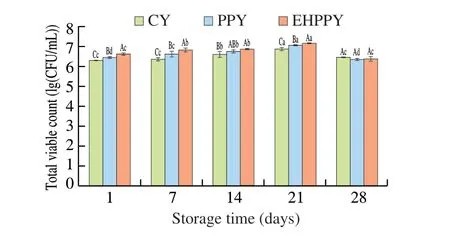
Fig. 3 Effect of added potato powder and EHPP on total viable of EHPPY,PPY and CY during 1, 7, 14, 21, 28 days storage.
3.4 WHC of yogurt during storage
WHC of yogurt is defined as the ability of yogurt to hold all or part of its water. After seven days of storage, WHC declined rapidly and after that, it steadily dropped. Moreover, adding of EHPP and PP increased the WHC of PPY and EHPPY samples positively (Fig. 4).The total solids and type of protein contents of yogurt greatly affect the WHC of yogurt. EHPPY and PPY showed a higher value of WHC as compared to CY throughout the storage period. Thus, higher WHC of PPY and EHPPY sample could be linked properties of different proteins in PPY and EHPPY as compared to CY. The changes in water WHC of yogurt samples may be attributed to the properties of different proteins. The increased WHC of yogurt with the addition of EHPP might be due to the high starch content of EHPP as compared to CY. The increased WHC of yoghurt with the addition of EHPP might be due to the high starch content of EHPP compared to control.The value of WHC in this study is similar with the finding of previous study who observed the increased WHC with the addition of peanut(more starch content) in milk yogurt [43]. Interaction of water with protein is very important in food systems because of their effects on flavor and texture of foods. Intrinsic factors effecting WHC foods proteins including amino acid composition, protein conformation and surface polarity [43]. Thus, higher WHC was detected in EHPPY and PPY containing EHPP and PP during storage, which could be associated with the different kind of proteins those present in the formulations and have greater effects on the WHC of the EHPPY and PPY than the total solids.
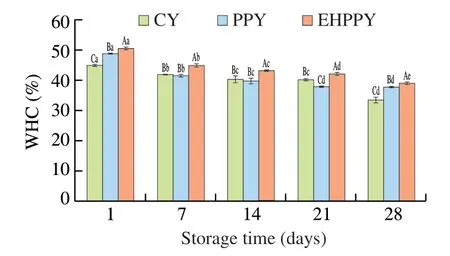
Fig. 4 Effect of added potato powder and EHPP on WHC of EHPPY, PPY and CY during 1, 7, 14, 21, 28 days storage.
3.5 Antioxidant activities of yogurt samples during storage
The effect of PP and EHPP on the DPPH free radical scavenging ability and ferric reducing antioxidant power (FRAP) of the yogurt samples was shown in Fig. 5. The DPPH free radical scavenging and FRAP values increased with the increase of storage period.Meanwhile, EHPPY showed higher values as compared to PPY and CY. Apart from this, an increase in the storage period also resulted in increased scavenging capabilities of DPPH free radicals and FRAP in a positive dose-effect relationship (P< 0.05). Previous reports have also highlighted that the antioxidant properties of yogurt are attributed to the involvement of many different amino acids and small molecular peptides and bioactive peptides produced during fermentation [44,45]. Besides this, the polyphenols of plant origin greatly improve the antioxidant properties of yogurts [46].It is interesting to mention that potato is strongly enriched with polyphenols well-known due to antioxidant activity [22,47]. The addition of the PP and EHPP resulted in the highest DPPH (FRSA)(Fig. 5a) and FRAP values (Fig. 5b) in EHPPY due to presence of polyphenols than PPY and CY. Moreover, caffeic and vanillic acids are very important antioxidants present in the potato that can effectively improve the DPPH free radicals scavenging and FRAP values of any fermented product [47] These findings suggested that polyphenols may have a major contribution to the increased antioxidant activity of EHPPY. Therefore, EHPPY containing EHPP could be used as a flavor fermented milk product with high health benefits.

Fig. 5 Effect of added potato powder and EHPP on antioxidant activity DPPH free radicals scavenging ability (FRSA) (a) and ferric reducing antioxidant power(FRAP) value (b) for antioxidant activity of EHPPY, PPY and CY during 1, 7, 14, 21, 28 days storage.
3.6 Rheological properties

Fig. 6 Effect of added potato powder and EHPP on rheological characteristics powder on storage G′ and G″ of EHPPY, PPY and CY heated from 4 to 50 °C (a)and from 50 to 4 °C (b) during 1, 7, 14, 21, 28 days storage at 4 °C. Subscript 1-5 represents 1, 7, 14, 21, 28 days storage at 4 ℃, respectively.
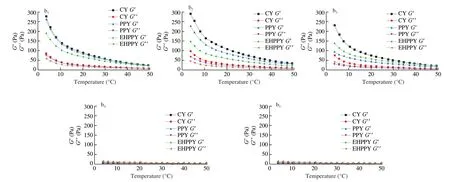
Fig. 6 (Continued)
Rheometry is a practical technique that provides an understanding of the physical properties of a product particularly before it is finally formulated for sensory testing and play a very important to understand determine the quality attributes of foods such as taste, texture and stability [48]. Viscoelastic property measurements give knowledge of the rheological characteristics of foods and provide an assessment of the initial experience of a consumer [49]. We used a dynamic temperature ramp test to evaluate the rheological properties of yogurt at the time of heating and cooling. This test is a usual practice when a fermented dairy product is subjected to refrigeration and de-refrigeration during consumption. Findings regarding storage modulus (G′) (elasticity) and loss modulus (G″)(viscosity) as a function of temperature for PP and EHPP supplemented yogurt and CY at days 1, 7, 14, 21 and 28 of storage are presented in Fig. 6. Additionally, the comparison of responses at different temperatures during cooling(50-4 °C) and heating (4-50 °C), the PP and EHPP supplemented yogurt responded variations from the CY sample. The PPY and EHPPY samples exhibited less value ofG′ andG″ as compared to CY in all temperatures throughout the storage period. All the samples showed primarily an elastic behavior (G′ >G″),G′ (storage)andG″ (loss) parameter follow the hysteresis loop at the time of heating and cooling and the decreasing trend was observed with increase in the temperature and increased back with the decrease in the temperature. The PPY and EHPPY showed the lowest values ofG′ andG″ at all the temperature ranges compared to CY, PPY and EHPPY showed lesser viscosity and elasticity which was significant than CY. Overall, PPY and EHPPY showed less viscosity and elasticity as compared to CY. However, reports available regarding the temperature ramp indicate that the samples supplemented with pea flour displayed more viscosity and elasticity which was significantly higher than the control sample indicating the dominancy of material [35].Our results dissimilar according to fore mention study because different nature of potato powder as compared to pea flour. However,the difference with CY was non-significant (P< 0.05). On day 28, PP and EHPP supplemented yogurt showed the lowerG′ andG″ values which were significantly (P< 0.05) less than the CY. Overall, PP and EHPP supplemented samples displayed less viscosity and elasticity compared to the control sample. The results, therefore, clearly show that EHPP supplementation significantly improved the desirable gel constancy of the fermented milk systems much more than the control samples (CY) during storage. This could be due to carbohydrates,especially the starch content of potato powder [24]. Potato powder could be useful in the manufacture of drinkable yogurt to reduced viscosity as compare whole milk powder and it is useful for texture modifiers being highly stable during cooling and heating in industry different food formulations.
3.7 Microstructure of yogurt samples during storage
Microstructure affects the textural properties of food and high interest. Such variation in the microstructures is indicative of modifications in its structural and physical properties due to PP and EHPP supplementation and cold storage [50]. The micrographs show variation in the structure of yogurt gel such as the density of the three-dimensional network of pore sizes and casein micelles(Fig. 7). Three-dimensional structure of the casein micelle network contained globular shapes, which were interspaced via void zones of the serum.
Apart from this, it was also observed that particles in the PP and EHPP supplemented yogurt micrographs (Fig. 7b and Fig. 7c). These findings are similar to the previous study [3], of fortified yogurt with the peel powder of pineapple enriched with fiber during refrigerated storage. Similar to their findings, we also found a more open network with larger pores in PP (Fig. 7b) and EHPP (Fig. 7c) supplemented than the CY non-supplemented plain yogurt (Fig. 7a). It could be due to thermodynamic incongruity between carbohydrates of PP and EHPP and milk proteins [51]. These results are consistent with the study of Lee et al. [52], who documented larger whey separation from a weak yogurt gel, which also had comparatively bigger pores in the gel arrangement. The size of the pores increased and a more open network was developed as a result of the increase inβ-glucans content in the milk fermentation during storage [53]. Additionally, reduced WHC of the structures produced in PPY and EHPPY samples might be the result of enlarged pores and reduced cross-linking between casein micelles during storage (Fig. 7). We also found casein networks more densely packed in the micrographs of stored yogurts of day 28 samples compared to day 1, which supports structural rearrangements during storage causing lower storage modulus of EHPPY.
3.8 Sensory analysis of yogurt samples during storage
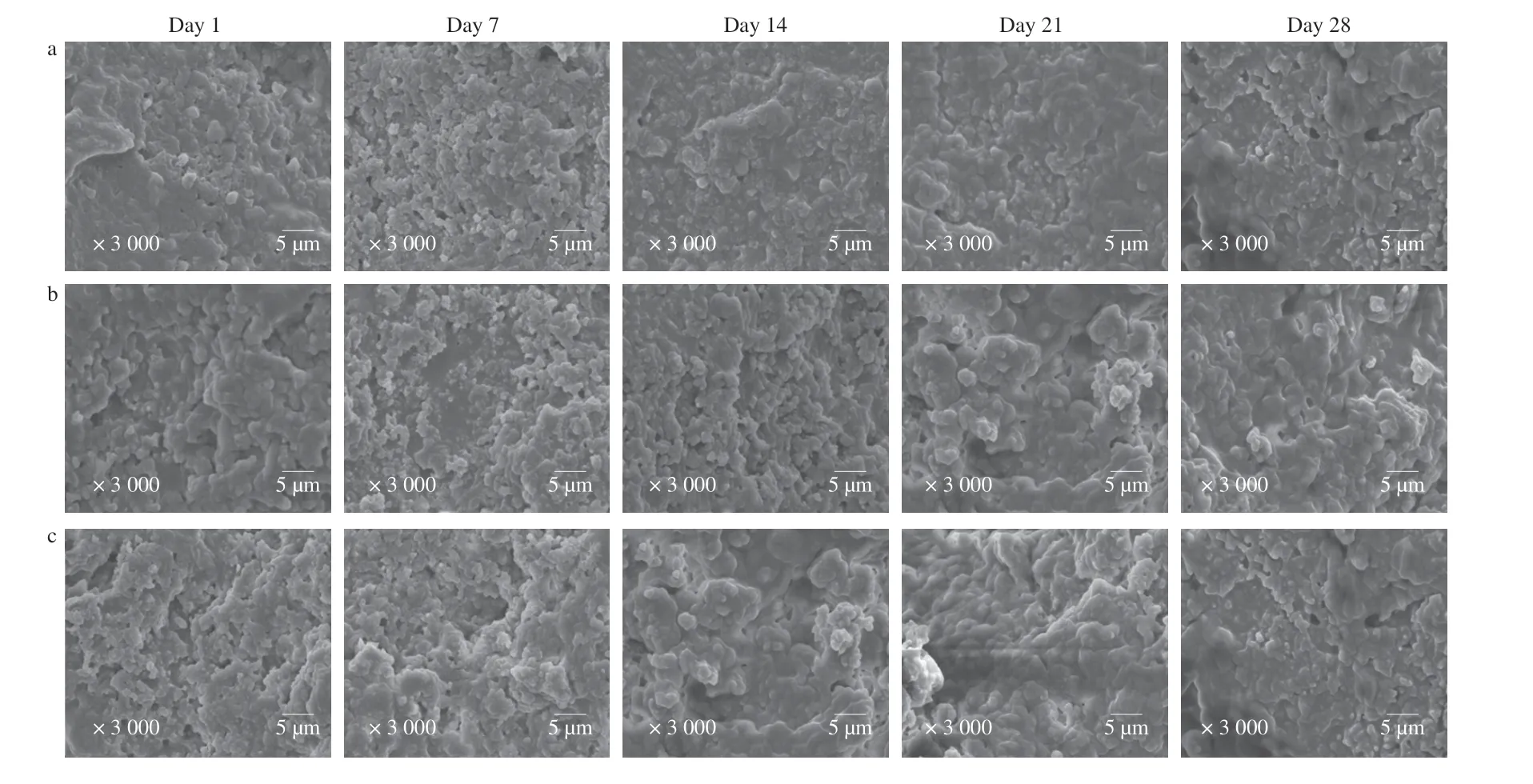
Fig. 7 Effect of added potato powder and enzyamtically hydrolyzed potato powder on microsturcture with (× 3 000, 5 μm) magnification micrographs.
The hedonic scale (Excellent = 5, Very good = 4, Good = 3,Average = 2 and Poor = 1), which was used for the determination of sensory test, indicated that yogurts with EHPP were relatively more acceptable by the panelists than PPY and CY (Table 1). The CY exhibited average acceptability. The taste (3.50 to 4.20) and aroma scores (3.14 to 4.20) of EHPPY were relatively higher as compared to other treatments i.e., CY and PPY. Many fatty acids that are volatile play a vital role in yogurt formulation and impart the taste and aroma of the end product [54]. Remarkable differences were also observed in taste, texture and color, among the treatments.The EHPPY was not statistically different (P< 0.05) from the CY.Furthermore, despite the lower syneresis and higher viscosity of yogurt produced with PP (PPY), in terms of organoleptic attributes were low in sensory score similar to those produced with EHPP(EHPPY). However, these sensory measurements are still subjective because the food preferences of panelists positively correlate with the sensory measurements [9]. Therefore, EHPP could be added in yogurt products as an effective additive to enhance the quality of EHPPY and contribute to the development of fermented dairy products.
4. Conclusion
The physiochemical, sensory properties and antioxidant activity of yogurt prepared in this study were positively affected after the addition of EHPP during the evaluated storage period. The WHC and overall acceptability of EHPPY were better than PPY and CY. However, to promote health benefits to panelists during theevaluated storage period, the viable count in the EHPPY formulation is sufficient (> 6.0 lg(CFU/mL)). Therefore, the current research shows that EHPP, as a new functional ingredient in flavor products,has sufficient structural and sensory qualities due to the potential functional properties of EHPP with the milk powder, and increases market value. With the study of storage stability, EHPPY can be used on commercial scale keeping in view the consequences of this study.
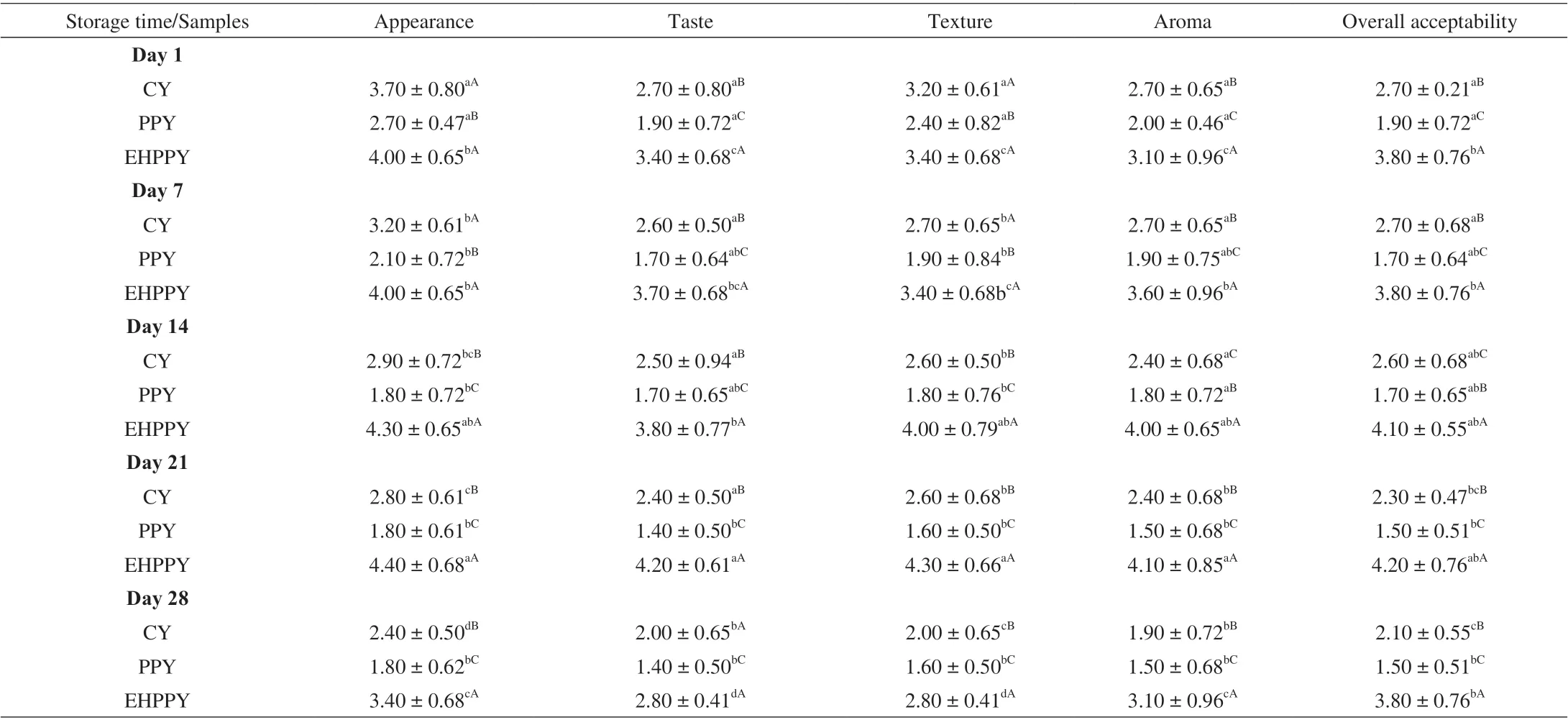
Table 1 Sensory evaluation parameters of CY, PPY and EHPPY.
Conflicts of interest
The authors declare no conflict of interest.
Acknowledgements
This work was financially supported by the Nature Science Foundation of Hubei Province (2018CFB269).
杂志排行
食品科学与人类健康(英文)的其它文章
- Evaluation and selection of yeasts as potential aroma enhancers for the production of dry-cured ham
- Preserved egg white alleviates DSS-induced colitis in mice through the reduction of oxidative stress, modulation of inf lammatory cytokines,NF-κB, MAPK and gut microbiota composition
- Energy status regulated umami compound metabolism in harvested shiitake mushrooms (Lentinus edodes) with spores triggered to release
- Edible mushrooms as a potent therapeutics of subclinical thyroid dysfunction among adults, especially in obese individuals: a prospective cohort study
- Screening hepatoprotective effective components of Lonicerae japonica Flos based on the spectrum-effect relationship and its mechanism exploring
- Effects of the degree of oral processing on the properties of saliva-participating emulsions: using stewed pork with brown sauce as the model
